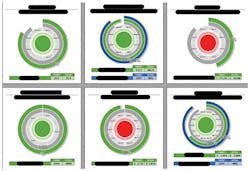Imagine for a moment that you are the left tackle for the Denver Broncos (or substitute whatever your favorite team is). You show up at Mile High Stadium and notice a bunch of people in jerseys the same color as yours so that is who you join. They tell you what to do in the huddle, and you go about doing it each play — but imagine this:
• At no point do you know if you are playing in a real game, an exhibition game, or a practice game. In fact, you are unsure if the other team is a practice squad or another NFL team.
• You are unsure if the game has started or if it’s still the warmup.
• You have no idea how a point is scored.
• You have no idea what the score is.
• You have no idea if the game has started, and if it has, when it is over.
As a coach and leader, one must ask how motivated is that player to do their job and stay engaged.
I believe that with rare exception, including mental illness, people come to work wanting to win the game. I don’t hear of many people (and I have engaged tens of thousands of them over my consulting career) coming to work saying to themselves, "Gee, I really want to lose today."
The trouble I have found is — like the football player above — people don’t know if the game has started, how to score a point, and if they are winning or losing. In these circumstances, virtual or face to face, can we blame them for disengaging?
10 CRITICAL FUNCTIONS
To ensure success for our teams, we as leaders have 10 critical functions to perform:
1. Define an inspiring game plan (Vision, Strategy) and define what we do on the field of play (Mission).
2. Define the rules to play by (Values).
3. Recruit the right players and make spring camp (onboarding) awesome.
4. Show and coach people on the play-book. (short-term goals)
5. Give each person frequent feedback. (performance management and coaching)
6. Give people the tools they need to win the game.
7. Show the team the score. (Publish a scoreboard and let the team have unfiltered access to it).
8. Let them play the game and spend time together frequently.
9. Protect your culture.
10. Trust your team and your process.
Each of these functions is critical in leading any organization; they are even more critical when leading an organization with a virtual work environment. The Internet is filled with a plethora of examples of both successes and failures regarding the success and viability of virtual work environments.
Recently, I have had the privilege of working with a team where the virtual workplace works quite well. I am by no means an expert at the virtual workplace; in fact, this was my first virtual workplace experience.
To begin with I was quite skeptical; however, my colleagues and I believed if we applied good leadership principles — like the 10 functions above — then the virtual workplace would work. We have grown from 3 executives to 20 team members in the last 12 months — with 60% of the team working virtually.
Although what we have done applies across all work environments (virtual and on-site), here are 9 ideas on how to succeed when leading a virtual workplace:
1. Define an inspiring game plan (Vision, Strategy) and define what we do on the field of play (Mission).
Formulate a clear Vision (why we exist) and Mission (what we do). Clearly define them, speak of them often and post them around the office, communication boards, and your shared drives. A Vision should excite people and ultimately be about making the world a better place. A Mission is more factual and not so inspirational. It helps an organization understand what we are doing and keeps us from getting distracted by shiny opportunities outside our play area.
Define a clear strategy that is easy to communicate to all.
We utilize the 1-Page Strategic Planning process published by Verne Harnish in his book Mastering The Rockefeller Habits (Select Books Inc, NY, 1st Ed. 2002). Our strategy is broken into a long-term Big Audacious Goal, then 3-year, 1-year, and quarterly goals. We visit and revise our strategy quarterly, then communicate results and changes.
2. Define the rules to play by (Values).
Values need to be defined clearly with outcome statements and behavior indicators. Be intentional about holding yourself and others accountable to the values, make them part of the daily conversation. Values should guide everyone’s behavior, including those who work virtually. Properly communicated values have three parts: Value word, Outcome Statement and Behavior Indicators.
Image 1: Our VMV card
3. Recruit the right players and make spring camp (onboarding) awesome.
We utilize a 4-stage hiring process:
Phase 1 — Introduction interview. Our questions screen for competence and character (based on our values).
Phase 2 — General knowledge questionnaire run by a third party. (We have found value in having this assessment be a position fit assessment tool.)
Phase 3 — Project testing which is role specific to test for skills.
Phase 4 — Requires the candidate to defend and explain their project.
All phases of the interview include associates from HR, the executive, and future fellow team leaders or members.
On-board well: Our onboarding process is completed virtually through Bamboo HR — our Human Resource Information System (HRIS) — prior to the new employee’s first day. This allows us to be productive with our new employees starting on their first day. A new employee receives an automated email from Bamboo prior to their start date asking them to complete various online pre-employment documents. The HRIS also asks them to answer introduction questions about themselves and their families. One of those questions asks them to identify their favorite candy. For virtual employees, we have their candy shipped to them via courier. I remember one of our team identified his favorite candy as "beer". It took some doing, but a 6-pack showed up at his door. On day one, each team member around the world receives the "employee’s welcome to the team notice" from Bamboo, including the answer to their questions. When the new employee shows up on day one, there are already numerous welcome messages in their email or slack channel from the team, and their favorite candy is sitting on their desk (or doorstep).
Make training occur early in the process: We offer training on Values Based Leadership, DiSC behavioral profiles, Situational Leadership within the first couple months of hire. This training is intended to guide communication, conflict resolution, teamwork, and clarity.
4. Show and coach people on the playbook (short-term goals).
Establish clear goals & objectives.
Each team member is shown and has access to a copy of our one-page strategic plan.
We utilize a scrum sprint process, including daily virtual stand-ups, weekly reviews, and 2-week goals.
Hold people accountable to their goals and tasks they agreed on. Sometimes accountability is humorous (cat videos), and sometimes it is more serious in the form of a discussion with your team or team leader).
5. Give each person frequent feedback (performance management and coaching).
Performance Management — make the formal assessment process frequent, simple, and quick. We utilize our Bamboo HR to facilitate the following:
Quarterly Supervisor and self-evaluation (5 key questions including one on values).
Confidential quarterly peer feedback filtered through the supervisor.
We take quarterly supervisor and self-evaluations along with peer feedback to develop a quarterly measure of employee engagement which the executives assess and take action.
6. Give people the tools they need to win the game.
Employees have input on the hardware we purchase for them.
We have built guidance in the form of an employee handbook where edits and suggestions are made continuously by the team.
Each team has a formal assessment based on Patrick Lencioni’s Five Behaviors. Review is broken into seven 1-hour discussions, and results in a team charter being developed.
We provide a safety program. Team members are encouraged to use safety tools like an ergonomic work station assessment to ensure the safest possible work environment.
We utilize Slack for internal communication, company e-mail for external, and Google drive for documents in shared folders.
7. Show the team the score (publish a scoreboard and let the team have unfiltered access to it).
Based on our strategic plan we identified quarterly and annual goals. Every 2 weeks, we update and send out the scorecard through Slack. It’s amazing the great questions people ask when they realize the team is losing on a goal — it’s always around "How do we win?" For scoreboards to be impacting, the scores need to be something individuals and/or teams can influence (i.e. quality, safety, customer loyalty, margin, employee engagement).
Image 2: Our scorecard is published every 2 weeks. We have redacted the score items.
8. Let them play the game and spend time together frequently:
Meet face-to-face frequently: My colleagues and I agreed we needed to invest in quarterly face-to-face team meetings (these are 1 week in duration, and involve work, play, and learning activities). We have discovered that bringing our global team together quarterly is priceless.
Image 3: Snowshoeing during our first team face-to-face meeting.
9. Protect your culture.
Guard your culture with passion. When team members are falling down, deal with it immediately. Work to help them succeed; however, if the probability of success is low, don’t be afraid to move them out. Nothing pulls high performers down more than leadership not dealing with a low performer.
10. Trust your team and your process.
At the end of day, not everyone is at their work station all the time. We could digress and wonder where they are, or we need to ask ourselves:
Have they let us know they are away from station?
Are they hitting their targets?
Are they attending all meetings on time and with effectiveness?
Are they demonstrating our values?
Are they supporting the team?
If the answer is yes, then let go of control and hang on to trust.
At Fresnel Software, we believe people wake up each morning and want to win the game. Our job is to inspire them with vision, mission, strategy, and clear goals. We need to equip them to succeed and give them feedback on how they are doing, (if they are winning or losing the game). We also need to let them play together.
A leader’s job is to define the culture and protect it. If you’ve done your job, then trusting your team should be easy. Where their work station is shouldn’t matter.
About the Author: Brock Brown is the VP-Sales, Training, People at Fresnel Software, a company focused on delivering an enterprise class, Cloud-based software platform enabling network owners and EPC vendors to manage their fiber access network deployment programs in a fully-integrated, end-to-end, GIS-enabled and mobile-empowered environment. Brock spent the last 20 years running an organizational leadership and development consulting company. For more information, please email [email protected] or visit www.fresnel.cc.







